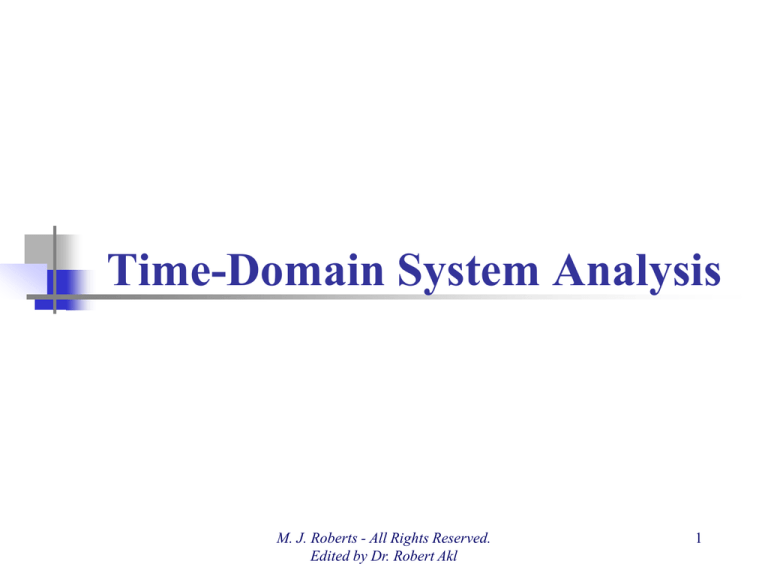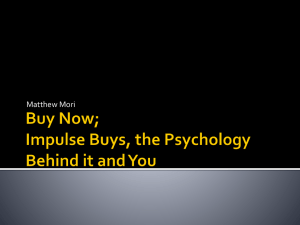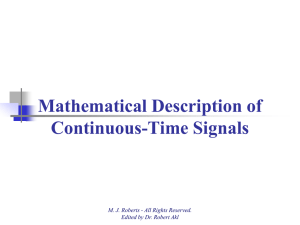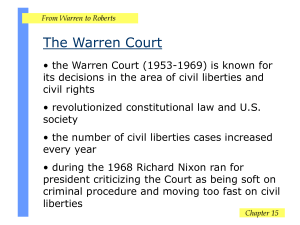
Time-Domain System Analysis
M. J. Roberts - All Rights Reserved.
Edited by Dr. Robert Akl
1
Continuous Time
M. J. Roberts - All Rights Reserved. Edited by Dr. Robert Akl
2
Impulse Response
Let a system be described by
a2 y¢¢ ( t ) + a1 y¢ ( t ) + a0 y ( t ) = x ( t )
and let the excitation be a unit impulse at time t = 0. Then the
zero-state response y is the impulse response h.
a2 h¢¢ ( t ) + a1 h¢ ( t ) + a0 h ( t ) = d ( t )
Since the impulse occurs at time t = 0 and nothing has excited
the system before that time, the impulse response before time
t = 0 is zero (because this is a causal system). After time t = 0
the impulse has occurred and gone away. Therefore there is no
longer an excitation and the impulse response is the homogeneous
solution of the differential equation.
M. J. Roberts - All Rights Reserved. Edited by Dr. Robert Akl
3
Impulse Response
a2 h¢¢ ( t ) + a1 h¢ ( t ) + a0 h ( t ) = d ( t )
What happens at time, t = 0? The equation must be satisfied at
all times. So the left side of the equation must be a unit impulse.
We already know that the left side is zero before time t = 0
because the system has never been excited. We know that the
left side is zero after time t = 0 because it is the solution of the
homogeneous equation whose right side is zero. These two facts
are both consistent with an impulse. The impulse response might
have in it an impulse or derivatives of an impulse since all of
these occur only at time, t = 0. What the impulse response does
have in it depends on the form of the differential equation.
M. J. Roberts - All Rights Reserved. Edited by Dr. Robert Akl
4
Impulse Response
Continuous-time LTI systems are described by differential
equations of the general form,
an y( n ) ( t ) + an-1 y( n-1) ( t ) +
+ a1 y¢ ( t ) + a0 y ( t )
= bm x( m ) ( t ) + bm-1 x( m-1) ( t ) +
+ b1 x¢ ( t ) + b0 x ( t )
For all times, t < 0:
If the excitation x ( t ) is an impulse, then for all time t < 0
it is zero. The response y ( t ) is zero before time t = 0
because there has never been an excitation before that time.
M. J. Roberts - All Rights Reserved. Edited by Dr. Robert Akl
5
Impulse Response
For all time t > 0:
The excitation is zero. The response is the homogeneous
solution of the differential equation.
At time t = 0:
The excitation is an impulse. In general it would be possible
for the response to contain an impulse plus derivatives of an
impulse because these all occur at time t = 0 and are zero
before and after that time. Whether or not the response contains
an impulse or derivatives of an impulse at time t = 0 depends
on the form of the differential equation
an y( n ) ( t ) + an-1 y( n-1) ( t ) +
+ a1 y¢ ( t ) + a0 y ( t )
= bm x( m ) ( t ) + bm-1 x( m-1) ( t ) +
+ b1 x¢ ( t ) + b0 x ( t )
M. J. Roberts - All Rights Reserved. Edited by Dr. Robert Akl
6
Impulse Response
an y( n ) ( t ) + an-1 y( n-1) ( t ) +
+ a1 y¢ ( t ) + a0 y ( t )
= bm x( m ) ( t ) + bm-1 x( m-1) ( t ) +
+ b1 x¢ ( t ) + b0 x ( t )
Case 1: m < n
If the response contained an impulse at time t = 0 then
the nth derivative of the response would contain the nth
derivative of an impulse. Since the excitation contains
only the mth derivative of an impulse and m < n, the
differential equation cannot be satisfied at time t = 0.
Therefore the response cannot contain an impulse or any
derivatives of an impulse.
M. J. Roberts - All Rights Reserved. Edited by Dr. Robert Akl
7
Impulse Response
an y( n ) ( t ) + an-1 y( n-1) ( t ) +
+ a1 y¢ ( t ) + a0 y ( t )
= bm x( m ) ( t ) + bm-1 x( m-1) ( t ) +
+ b1 x¢ ( t ) + b0 x ( t )
Case 2: m = n
In this case the highest derivative of the excitation and
response are the same and the response could contain an
impulse at time t = 0 but no derivatives of an impulse.
Case 3: m > n
In this case, the response could contain an impulse at
time t = 0 plus derivatives of an impulse up to the
(m - n)th derivative.
Case 3 is rare in the analysis of practical systems.
M. J. Roberts - All Rights Reserved. Edited by Dr. Robert Akl
8
Impulse Response
Example
Let a system be described by y¢ ( t ) + 3y ( t ) = x ( t ) . If the excitation
x is an impulse we have h¢ ( t ) + 3h ( t ) = d ( t ) . We know that
h ( t ) = 0 for t < 0 and that h ( t ) is the homogeneous solution for
t > 0 which is h ( t ) =Ke-3t . There are more derivatives of y than
of x. Therefore the impulse response cannot contain an impulse.
So the impulse response is h ( t ) = Ke-3t u ( t ) .
M. J. Roberts - All Rights Reserved. Edited by Dr. Robert Akl
9
Impulse Response
M. J. Roberts - All Rights Reserved. Edited by Dr. Robert Akl
10
Impulse Response
M. J. Roberts - All Rights Reserved. Edited by Dr. Robert Akl
11
Impulse Response
M. J. Roberts - All Rights Reserved. Edited by Dr. Robert Akl
12
Impulse Response
M. J. Roberts - All Rights Reserved. Edited by Dr. Robert Akl
13
Impulse Response
Example h ( t ) = ( -3 / 16 ) e-3t / 4 u ( t ) + (1 / 4 ) d ( t )
The original differential equation is 4 h¢ ( t ) + 3h ( t ) = d ¢ ( t ) .
Substituting the solution we get
ì d
ü
-3t / 4
é
ù
4
-3
/
16
e
u
t
+
1
/
4
d
t
(
)
(
)
(
)
(
)
ï dt ë
ûï
í
ý = d ¢ (t )
ï+3 é( -3 / 16 ) e-3t / 4 u ( t ) + (1 / 4 ) d ( t ) ù ï
û þ
î ë
ìï 4 éë( -3 / 16 ) e-3t / 4d ( t ) + ( 9 / 64 ) e-3t / 4 u ( t ) + (1 / 4 ) d ¢ ( t ) ùû üï
í
ý = d ¢ (t )
-3t / 4
u ( t ) + (1 / 4 ) d ( t ) ùû
ïî+3 éë( -3 / 16 ) e
ïþ
- ( 3 / 4 ) e-3t / 4d ( t ) + ( 9 / 16 ) e-3t / 4 u ( t ) + d ¢ ( t ) - ( 9 / 16 ) e-3t / 4 u ( t ) + ( 3 / 4 ) d ( t ) = d ¢ ( t )
d ¢ (t ) = d ¢ (t )
Check.
M. J. Roberts - All Rights Reserved. Edited by Dr. Robert Akl
14
The Convolution Integral
If a continuous-time LTI system is excited by an arbitrary
excitation, the response could be found approximately by
approximating the excitation as a sequence of contiguous
rectangular pulses of width Tp .
Exact
Excitation
Approximate
Excitation
M. J. Roberts - All Rights Reserved. Edited by Dr. Robert Akl
15
The Convolution Integral
M. J. Roberts - All Rights Reserved. Edited by Dr. Robert Akl
16
The Convolution Integral
Let the response to an unshifted pulse of unit area and width T p
be the “unit pulse response” h p ( t ) . Then, invoking linearity, the
response to the overall excitation is (approximately) a sum of shifted
and scaled unit pulse responses of the form
y (t ) @
¥
å T x ( nT ) h ( t - nT )
p
p
p
p
n=-¥
As T p approaches zero, the unit pulses become unit impulses,
the unit pulse response becomes the unit impulse response h(t)
and the excitation and response become exact.
M. J. Roberts - All Rights Reserved. Edited by Dr. Robert Akl
17
The Convolution Integral
Let the unit pulse response be that of the RC lowpass filter
æ 1 - e-( t +Tp /2 ) /RC ö æ T p ö æ 1- e-( t +Tp /2 ) /RC ö æ T p ö
h p (t ) = ç
÷ uçt + ÷ - ç
÷ uçt - ÷
Tp
2ø è
Tp
2ø
è
ø è
ø è
M. J. Roberts - All Rights Reserved. Edited by Dr. Robert Akl
18
The Convolution Integral
Let x ( t ) be this smooth waveform and let it be approximated
by a sequence of rectangular pulses.
M. J. Roberts - All Rights Reserved. Edited by Dr. Robert Akl
19
The Convolution Integral
The approximate excitation is a sum of rectangular pulses.
M. J. Roberts - All Rights Reserved. Edited by Dr. Robert Akl
20
The Convolution Integral
The approximate response is a sum of pulse responses.
M. J. Roberts - All Rights Reserved. Edited by Dr. Robert Akl
21
The Convolution Integral
Tp = 0.1 s
M. J. Roberts - All Rights Reserved. Edited by Dr. Robert Akl
22
The Convolution Integral
Tp = 0.05 s
M. J. Roberts - All Rights Reserved. Edited by Dr. Robert Akl
23
The Convolution Integral
As T p approaches zero, the expressions for the approximate
excitation and response approach the limiting exact forms
Superposition Integral
x (t ) =
¥
ò x (t ) d ( t - t ) d t
Convolution Integral
y (t ) =
-¥
M. J. Roberts - All Rights Reserved. Edited by Dr. Robert Akl
¥
ò x (t ) h ( t - t ) d t
-¥
24
The Convolution Integral
Another (quicker) way to develop the convolution integral is
to start with x ( t ) =
¥
ò x (t )d ( t - t ) dt which follows directly
-¥
from the sampling property of the impulse. If h ( t ) is the impulse
response of the system, and if the system is LTI, then the response
to x (t ) d ( t - t ) must be x (t ) h ( t - t ) . Then, invoking additivity,
if x ( t ) =
¥
¥
-¥
-¥
ò x (t )d ( t - t ) dt , then y ( t ) = ò x (t ) h ( t - t ) dt .
M. J. Roberts - All Rights Reserved. Edited by Dr. Robert Akl
25
A Graphical Illustration of the
Convolution Integral
The convolution integral is defined by
x (t ) * h (t ) =
¥
ò x (t ) h ( t - t ) d t
-¥
For illustration purposes let the excitation x ( t ) and the
impulse response h ( t ) be the two functions below.
M. J. Roberts - All Rights Reserved. Edited by Dr. Robert Akl
26
A Graphical Illustration of the
Convolution Integral
In the convolution integral there is a factor h ( t - t ) .
We can begin to visualize this quantity in the graphs below.
M. J. Roberts - All Rights Reserved. Edited by Dr. Robert Akl
27
A Graphical Illustration of the
Convolution Integral
The functional transformation in going from h ( t ) to h ( t - t ) is
®- t
®t -t
h (t ) ¾t¾¾
® h ( -t ) ¾t¾¾
® h ( - (t - t ) ) = h ( t - t )
M. J. Roberts - All Rights Reserved. Edited by Dr. Robert Akl
28
A Graphical Illustration of the
Convolution Integral
The convolution value is the area under the product of x ( t )
and h ( t - t ) . This area depends on what t is. First, as an
example, let t = 5.
For this choice of t the area under the product is zero.
Therefore if y(t) = x ( t ) * h ( t ) then y(5) = 0.
M. J. Roberts - All Rights Reserved. Edited by Dr. Robert Akl
29
A Graphical Illustration of the
Convolution Integral
Now let t = 0.
Therefore y ( 0 ) = 2, the area under the product.
M. J. Roberts - All Rights Reserved. Edited by Dr. Robert Akl
30
A Graphical Illustration of the
Convolution Integral
The process of convolving to find y(t) is illustrated below.
M. J. Roberts - All Rights Reserved. Edited by Dr. Robert Akl
31
A Graphical Illustration of the
Convolution Integral
e- (t -t ) / RC
vout ( t ) = ò x (t ) h ( t - t ) dt = ò u (t )
u ( t - t ) dt
RC
-¥
-¥
¥
¥
M. J. Roberts - All Rights Reserved. Edited by Dr. Robert Akl
32
A Graphical Illustration of the
Convolution Integral
t < 0 : vout ( t ) = 0
e- ( t -t ) / RC
vout ( t ) = ò u (t )
u ( t - t ) dt
RC
-¥
¥
t >0:
- ( t - t ) / RC
t
t
ù
1
1 ée
- ( t - t ) / RC
- ( t - t ) / RC
-t / RC
é
ù
vout ( t ) =
e
d
t
=
=
-e
=
1
e
ê
ú ë
ò
û0
RC 0
RC ë -1 / RC û 0
For all time, t:
t
(
)
vout ( t ) = 1 - e-t / RC u ( t )
M. J. Roberts - All Rights Reserved. Edited by Dr. Robert Akl
33
Convolution Example
M. J. Roberts - All Rights Reserved. Edited by Dr. Robert Akl
34
Convolution Example
M. J. Roberts - All Rights Reserved. Edited by Dr. Robert Akl
35
Convolution Integral Properties
x ( t ) * Ad ( t - t 0 ) = A x ( t - t 0 )
If g ( t ) = g 0 ( t ) * d ( t ) then g ( t - t 0 ) = g 0 ( t - t 0 ) * d ( t ) = g 0 ( t ) * d ( t - t 0 )
If y ( t ) = x ( t ) * h ( t ) then y¢ ( t ) = x¢ ( t ) * h ( t ) = x ( t ) * h¢ ( t )
and y ( at ) = a x ( at ) * h ( at )
Commutativity
x (t ) * y (t ) = y (t ) * x (t )
Associativity
éë x ( t ) * y ( t ) ùû * z ( t ) = x ( t ) * éë y ( t ) * z ( t ) ùû
Distributivity
éë x ( t ) + y ( t ) ùû * z ( t ) = x ( t ) * z ( t ) + y ( t ) * z ( t )
M. J. Roberts - All Rights Reserved. Edited by Dr. Robert Akl
36
The Unit Triangle Function
ì1 - t , t < 1ü
tri ( t ) = í
ý = rect ( t ) * rect ( t )
, t ³ 1þ
î0
The unit triangle, is the convolution of a unit rectangle with
Itself.
M. J. Roberts - All Rights Reserved. Edited by Dr. Robert Akl
37
System Interconnections
If the output signal from a system is the input signal to a second
system the systems are said to be cascade connected.
It follows from the associative property of convolution that the
impulse response of a cascade connection of LTI systems is the
convolution of the individual impulse responses of those systems.
Cascade
Connection
M. J. Roberts - All Rights Reserved. Edited by Dr. Robert Akl
38
System Interconnections
If two systems are excited by the same signal and their responses
are added they are said to be parallel connected.
It follows from the distributive property of convolution that the
impulse response of a parallel connection of LTI systems is the
sum of the individual impulse responses.
Parallel
Connection
M. J. Roberts - All Rights Reserved. Edited by Dr. Robert Akl
39
Unit Impulse Response and Unit
Step Response
In any LTI system let an excitation x ( t ) produce the response
d
y ( t ) . Then the excitation ( x ( t ) ) will produce the response
dt
d
y ( t ) ) . It follows then that the unit impulse response h ( t ) is
(
dt
the first derivative of the unit step response h -1 ( t ) and, conversely
that the unit step response h -1 ( t ) is the integral of the unit
impulse response h ( t ) .
M. J. Roberts - All Rights Reserved. Edited by Dr. Robert Akl
40
Stability and Impulse Response
A system is BIBO stable if its impulse response is
absolutely integrable. That is if
¥
ò h ( t ) dt is finite.
-¥
M. J. Roberts - All Rights Reserved. Edited by Dr. Robert Akl
41
Systems Described by
Differential Equations
The most general form of a differential equation describing an
N
LTI system is å ak y
M
(k )
k =0
( t ) = å bk x(k ) ( t ).
k =0
Let x ( t ) = Xe st and
let y ( t ) = Ye st . Then x( k ) ( t ) = s k Xe st and y( k ) ( t ) = s kYe st and
N
å a s Ye
k
st
k
k =0
M
= å bk s k Xe st .
k =0
The differential equation has become an algebraic equation.
N
M
Y
Ye å ak s = Xe å bk s Þ =
X
k =0
k =0
st
k
st
k
k
b
s
å k =0 k
M
k
a
s
å k =0 k
M. J. Roberts - All Rights Reserved. Edited by Dr. Robert Akl
N
42
Systems Described by
Differential Equations
The transfer function for systems of this type is
k
b
s
å k =0 k
M
bM s M + bM -1s M -1 + + b2 s 2 + b1s + b0
H ( s) = N
=
N
N -1
2
k
a
s
+
a
s
+
+
a
s
+ a1s + a0
N
N -1
2
å k =0 ak s
This type of function is called a rational function because it is
a ratio of polynomials in s. The transfer function encapsulates
all the system characteristics and is of great importance in signal
and system analysis.
M. J. Roberts - All Rights Reserved. Edited by Dr. Robert Akl
43
Systems Described by
Differential Equations
Now let x ( t ) = Xe jw t and let y ( t ) = Ye jw t .
This change of variable s ® jw changes the transfer function
to the frequency response.
H ( jw ) =
bM ( jw ) + bM -1 ( jw )
M
aN ( jw ) + aN -1 ( jw )
N
M -1
N -1
+
+
+ b2 ( jw ) + b1 ( jw ) + b0
2
+ a2 ( jw ) + a1 ( jw ) + a0
2
Frequency response describes how a system responds to a
sinusoidal excitation, as a function of the frequency of that
excitation.
M. J. Roberts - All Rights Reserved. Edited by Dr. Robert Akl
44
Systems Described by
Differential Equations
It is shown in the text that if an LTI system is excited by a
sinusoid x ( t ) = Ax cos (w 0t + q x ) that the response is
(
)
y ( t ) = Ay cos w 0t + q y where Ay = H ( jw 0 ) Ax and
qy =
H ( jw 0 ) + q x .
M. J. Roberts - All Rights Reserved. Edited by Dr. Robert Akl
45
MATLAB System Objects
M. J. Roberts - All Rights Reserved. Edited by Dr. Robert Akl
46
MATLAB System Objects
M. J. Roberts - All Rights Reserved. Edited by Dr. Robert Akl
47
Discrete Time
M. J. Roberts - All Rights Reserved. Edited by Dr. Robert Akl
48
Impulse Response
Discrete-time LTI systems are described mathematically
by difference equations of the form
a0 y [ n ] + a1 y [ n - 1] +
+ aN y [ n - N ]
= b0 x [ n ] + b1 x [ n - 1] +
+ bM x [ n - M ]
For any excitation x [ n ] the response y [ n ] can be found by
finding the response to x [ n ] as the only forcing function on the
right-hand side and then adding scaled and time-shifted
versions of that response to form y [ n ] .
If x [ n ] is a unit impulse, the response to it as the only forcing
function is simply the homogeneous solution of the difference
equation with initial conditions applied. The impulse response
is conventionally designated by the symbol h [ n ] .
M. J. Roberts - All Rights Reserved. Edited by Dr. Robert Akl
49
Impulse Response
Since the impulse is applied to the system at time n = 0,
that is the only excitation of the system and the system is
causal the impulse response is zero before time n = 0.
h[n] = 0 , n < 0
After time n = 0, the impulse has come and gone and the
excitation is again zero. Therefore for n > 0, the solution of
the difference equation describing the system is the
homogeneous solution.
h [ n] = yh [ n] , n > 0
Therefore, the impulse response is of the form,
h [ n] = yh [ n] u [ n]
M. J. Roberts - All Rights Reserved. Edited by Dr. Robert Akl
50
Impulse Response Example
Let a system be described by 4 y [ n ] - 3y [ n - 1] = x [ n ] . Then,
if the excitation is a unit impulse, 4 h [ n ] - 3h [ n - 1] = d [ n ] .
The eigenfunction is the complex exponential z n . Substituting
into the homogeneous difference equation, 4z n - 3z n-1 = 0.
Dividing through by z n-1 , 4z - 3 = 0. Solving, z = 3 / 4. The
homogeneous solution is then of the form h [ n ] = K ( 3 / 4 )
M. J. Roberts - All Rights Reserved. Edited by Dr. Robert Akl
n
.
51
Impulse Response Example
M. J. Roberts - All Rights Reserved. Edited by Dr. Robert Akl
52
Impulse Response Example
Let a system be described by 3y [ n ] + 2 y [ n - 1] + y [ n - 2 ] = x [ n ] .
Then, if the excitation is a unit impulse,
3h [ n ] + 2 h [ n - 1] + h [ n - 2 ] = d [ n ]
The eigenfunction is the complex exponential z n . Substituting
into the homogeneous difference equation,
3z n + 2z n-1 + z n-2 = 0.
Dividing through by z n-2 , 3z 2 + 2z + 1 = 0.
Solving, z = -0.333 ± j0.4714. The homogeneous solution is
then of the form
h [ n ] = K1 ( -0.333 + j0.4714 ) + K 2 ( -0.333 - j0.4714 )
n
M. J. Roberts - All Rights Reserved. Edited by Dr. Robert Akl
n
53
Impulse Response Example
M. J. Roberts - All Rights Reserved. Edited by Dr. Robert Akl
54
Impulse Response Example
The impulse response is then
é( 0.1665 + j0.1181) ( -0.333 + j0.4714 )n ù
h[n] = ê
ú u[n]
n
êë + ( 0.1665 - j0.1181) ( -0.333 - j0.4714 ) úû
which can also be written in the forms,
j 2.1858n
ù
é
e
j0.1181
+
0.1665
)
(
n
u[ n]
h [ n ] = ( 0.5722 ) ê
- j 2.1858n ú
úû
êë + ( 0.1665 - j0.1181) e
(
)
- j 2.1858n
j 2.1858n
é
e
+
e
0.1665
n
h [ n ] = ( 0.5722 ) ê
êë + j0.1181 e j 2.1858n - e- j 2.1858n
(
)
ù
ú u[n]
úû
h [ n ] = ( 0.5722 ) éë 0.333cos ( 2.1858n ) - 0.2362 sin ( 2.1858n ) ùû u [ n ]
n
h [ n ] = 0.4083 ( 0.5722 ) cos ( 2.1858n + 0.6169 )
n
M. J. Roberts - All Rights Reserved. Edited by Dr. Robert Akl
55
Impulse Response Example
h [ n ] = 0.4083 ( 0.5722 ) cos ( 2.1858n + 0.6169 )
n
M. J. Roberts - All Rights Reserved. Edited by Dr. Robert Akl
56
System Response
• Once the response to a unit impulse is
known, the response of any LTI system to
any arbitrary excitation can be found
• Any arbitrary excitation is simply a sequence
of amplitude-scaled and time-shifted
impulses
• Therefore the response is simply a sequence
of amplitude-scaled and time-shifted impulse
responses
M. J. Roberts - All Rights Reserved. Edited by Dr. Robert Akl
57
Simple System Response Example
M. J. Roberts - All Rights Reserved. Edited by Dr. Robert Akl
58
More Complicated System
Response Example
System
Excitation
System
Impulse
Response
System
Response
M. J. Roberts - All Rights Reserved. Edited by Dr. Robert Akl
59
The Convolution Sum
The response y [ n ] to an arbitrary excitation x [ n ] is of the form
y[n] =
x [ -1] h [ n + 1] + x [ 0 ] h [ n ] + x [1] h [ n - 1] +
where h [ n ] is the impulse response. This can be written in
a more compact form
y[n] =
¥
å x[ m]h[n - m]
m=-¥
called the convolution sum.
M. J. Roberts - All Rights Reserved. Edited by Dr. Robert Akl
60
A Convolution Sum Example
M. J. Roberts - All Rights Reserved. Edited by Dr. Robert Akl
61
A Convolution Sum Example
M. J. Roberts - All Rights Reserved. Edited by Dr. Robert Akl
62
A Convolution Sum Example
M. J. Roberts - All Rights Reserved. Edited by Dr. Robert Akl
63
A Convolution Sum Example
M. J. Roberts - All Rights Reserved. Edited by Dr. Robert Akl
64
Convolution Sum Properties
Convolution is defined mathematically by
y[n] = x[n] * h[n] =
¥
å x[ m]h[n - m]
m=-¥
The following properties can be proven from the definition.
x [ n ] * Ad [ n - n0 ] = A x [ n - n0 ]
Let y [ n ] = x [ n ] * h [ n ] then
y [ n - n0 ] = x [ n ] * h [ n - n0 ] = x [ n - n0 ] * h [ n ]
y [ n ] - y [ n - 1] = x [ n ] * ( h [ n ] - h [ n - 1]) = ( x [ n ] - x [ n - 1]) * h [ n ]
and the sum of the impulse strengths in y is the product of
the sum of the impulse strengths in x and the sum of the
impulse strengths in h.
M. J. Roberts - All Rights Reserved. Edited by Dr. Robert Akl
65
Convolution Sum Properties
(continued)
Commutativity
x[ n] * y[ n] = y[n] * x[n]
Associativity
( x [ n ] * y [ n ]) * z [ n ] = x [ n ] * ( y [ n ] * z [ n ])
Distributivity
( x [ n ] + y [ n ]) * z [ n ] = x [ n ] * z [ n ] + y [ n ] * z [ n ]
M. J. Roberts - All Rights Reserved. Edited by Dr. Robert Akl
66
Numerical Convolution
M. J. Roberts - All Rights Reserved. Edited by Dr. Robert Akl
67
Numerical Convolution
M. J. Roberts - All Rights Reserved. Edited by Dr. Robert Akl
68
Numerical Convolution
M. J. Roberts - All Rights Reserved. Edited by Dr. Robert Akl
69
Numerical Convolution
M. J. Roberts - All Rights Reserved. Edited by Dr. Robert Akl
70
Numerical Convolution
The integral can be approximated at discrete points in time as
( ) å x ( mT ) h (( n - m) T ) T
y nTs @
¥
m=-¥
s
s
s
This can be expressed in terms of a convolution sum as
( )
y nTs @ Ts
¥
å x éë mùû h éë n - mùû = T x éë n ùû * h éë n ùû
m=-¥
( )
s
( )
where x éë n ùû = x nTs and h éë n ùû = h nTs .
M. J. Roberts - All Rights Reserved. Edited by Dr. Robert Akl
71
Stability and Impulse Response
It can be shown that a discrete-time BIBO-stable system
has an impulse response that is absolutely summable.
That is,
¥
å h [ n ] is finite.
n=-¥
M. J. Roberts - All Rights Reserved. Edited by Dr. Robert Akl
72
System Interconnections
The cascade connection of two systems can be viewed as
a single system whose impulse response is the convolution
of the two individual system impulse responses. This is a
direct consequence of the associativity property of
convolution.
M. J. Roberts - All Rights Reserved. Edited by Dr. Robert Akl
73
System Interconnections
The parallel connection of two systems can be viewed as
a single system whose impulse response is the sum
of the two individual system impulse responses. This is a
direct consequence of the distributivity property of
convolution.
M. J. Roberts - All Rights Reserved. Edited by Dr. Robert Akl
74
Unit Impulse Response and Unit
Sequence Response
In any LTI system let an excitation x [ n ] produce the response
y [ n ] . Then the excitation x [ n ] - x [ n - 1] will produce the
response y [ n ] - y [ n - 1] .
It follows then that the unit impulse response is the first
backward difference of the unit sequence response and,
conversely that the unit sequence response is the accumulation
of the unit impulse response.
M. J. Roberts - All Rights Reserved. Edited by Dr. Robert Akl
75
Systems Described by
Difference Equations
The most common description of a discrete-time system is a
difference equation of the general form
N
M
å a y [ n - k ] = å b x [ n - k ].
k
k
k =0
k =0
If x [ n ] = Xz n , y [ n ] has the form y [ n ] = Yz n where X and Y are
complex constants. Then x [ n - k ] = z - k Xz n and
y [ n - k ] = z Yz and
-k
N
n
N
n
k =0
k =0
M
Yz n å ak z - k = Xz n å bk z - k Þ
k=0
M
-k
n
a
z
Yz
=
b
z
Xz
. Rearranging
å k
åk
-k
k =0
Y
=
X
-k
b
z
å k =0 k
M
-k
a
z
å k =0 k
N
M. J. Roberts - All Rights Reserved. Edited by Dr. Robert Akl
76
Systems Described by
Difference Equations
The transfer function is
-k
b
z
åk=0 k
M
H ( z) =
b0 + b1z -1 + b2 z -2 +
=
a0 + a1z -1 + a2 z -2 +
-k
a
z
åk=0 k
N
+ bM z - M
+ aN z - N
or, alternately,
-k
b
z
åk=0 k
M
H ( z) =
å
N
k=0
ak z
-k
=z
N-M
b0 z M + b1z M -1 +
a0 z N + a1z N -1 +
+ bM -1z + bM
+ aN -1z + aN
The transform can be written directly from the difference
equation and vice versa.
M. J. Roberts - All Rights Reserved. Edited by Dr. Robert Akl
77
Frequency Response
Let x [ n ] = Xe jWn . Then y [ n ] = Ye jWn and x [ n - k ] = e- jWk Xe jWn and
y [ n - k ] = e- jWkYe jWn . Then the general difference equation
description of a discrete-time system
N
M
å a y[n - k ] = å b x[n - k ]
k
k
k =0
k =0
becomes
Ye
jWn
N
å ak e
k =0
- jWk
= Xe
jWn
M
- jWk
b
e
åk
k =0
M. J. Roberts - All Rights Reserved. Edited by Dr. Robert Akl
78
Frequency Response
M. J. Roberts - All Rights Reserved. Edited by Dr. Robert Akl
79
Frequency Response Example
M. J. Roberts - All Rights Reserved. Edited by Dr. Robert Akl
80
Frequency Response Example
M. J. Roberts - All Rights Reserved. Edited by Dr. Robert Akl
81






